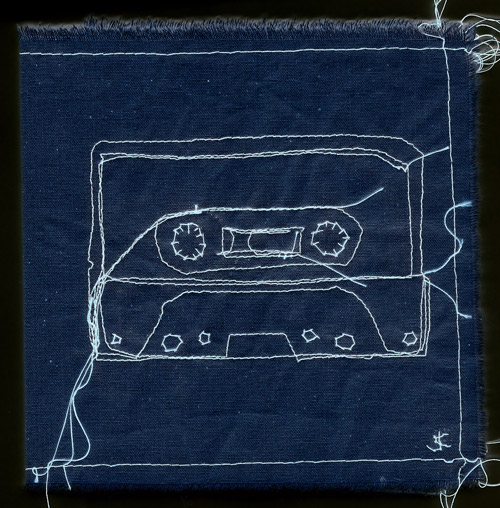God I miss mixed tapes.
(Which begs the question: Is it mixed tape, mix tape or mixtape? I say all of the above, and shall use them interchangeably.)
I know this is an old school skill that everyone boasts about; people have even written books about it: some of the stories are successful, some are very good novels that were inevitably made into very mediocre movies.
You can, of course, approximate the experience via iPod and playlists. Anyone can do that. And that’s the problem: anyone can do it. It’s too easy. It might even be easier to create superior product, because when the entire world is your library (also called iTunes), there are no limitations a quick download can’t conquer. But a mixed tape, aside from being an art unto itself (which songs would, assembled in the appropriate order, come as close as humanly possible to 45 minutes per side, often requiring a calculator and album credits to ensure individual song lengths), demanded effort and considerable deliberation, all based on songs already available to the mix-maker. Thus, it was truly a reflection of one’s personality; these were songs the individual had cared about enough to own the album (or, ahem, the CD) in the first place.
For a mix of one specific band, it was a wonderfully excruciating exercise in mixology; the methodology was distinctly Darwinian: only the strongest would survive. Therefore, if you were making a 90-minute mix for, say, Led Zeppelin or The Doors, you had to necessarily eschew some of the longer (and better) tracks to ensure maximum bang for the proverbial buck. Not much point in taking up half of one precious side to ensure that “When The Music’s Over” and “The End” made the cut; or, while it’s hard to argue that “In My Time of Dying” and “Tea For One” don’t belong on any Zep mix, you could fit in “I Can’t Quit You Baby”, “That’s The Way”, “Down By The Seaside” and “For Your Life” in the same space. Of course, mixes for the ’70s prog supergroups were difficult, (think Genesis or King Crimson), to impossible, (think Yes or Pink Floyd.) Sometimes, you simply had to get creative: for a semi-encompassing summation of Rush’s oeuvre (understanding that at minimum two tapes were necessary: one for their first decade and one for their second), you had to cut and paste the old fashioned way. Can’t fit 2112 on, but it has to be included, so perhaps you just put in “Discovery” or “Oracle: The Dream”, or (like I did) just do a several minute pastiche of all the guitar solos from the entire opus. With Pink Floyd, you had to have the epic side-long suites represented in some fashion, so you just took the magisterial opening section from “Atom Heart Mother” or perhaps Part One of “Dogs” (or perhaps Part Two) and, obviously, you had to use your best judgment regarding “Shine On You Crazy Diamond”. It goes without saying that the type of band mix differed depending on the target audience: if it was for personal use, anything was allowed. For friends, particularly ones uninitiated with the artist in question, it was incumbent upon the mix-maker to ensure all the essential tracks (i.e., the ones that did or would show up on a greatest hits album) were chosen (whereas those invariably didn’t make it onto the personal mixes, for a variety of functional and aesthetic reasons). Mix, play repeat: Practice made perfect.
The primary M.O. for mix tapes, of course, was for the intrigue they added to relationships. A mixed tape was de rigueur for establishing, assessing and understanding the various levels of any serious romance. The first mix was as important, in its way, as the first kiss: too early and you could blow it; too late and you may have missed an opportunity to send the right signal at the right time. This ground has been covered ad nauseam and everyone who ever gave or received a mixed tape will recall the rules of engagement. If you remember mixed tapes you received without the slightest pang of remorse, enthrallment or unforced sentimentality, either the relationship or the tape sucked. Probably both. (My condolences.) I know I ended up missing some of the mix tape miracles I gave away more than I missed the women I made them for (which is not necessarily a commentary on the enthralling women who tolerated me for any amount of time so much as an unapologetic appraisal of the one thing I always got right).
Intermission: If this guy wasn’t on one of your mix-tapes, your problems exceeded simple musical myopia:
It occurs to me that I’m probably the only person who believes some of his finer mixes should be enshrined in The Smithsonian.
If obliged to select a few for canonization, among the first inductees for my mix tape Hall of Fame ballot would be Say It Once Say It Loud, I’m Black and I’m Proud Vol. 2 (Volume One covered off some of the more readily accessible (i.e., car-friendly) material from mix tape MVP James Brown, Stevie Wonder, Marvin Gaye, Sam Cooke, et cetera, while subsequent volumes covered the bases and the outfield with everyone from Otis Redding and Louis Jordan to Johnny Ace and Sly Stone). Vol. 2 was the sum of its parts, which means it was an embarrassment of riches. It started with Marley’s “Natural Mystic” and ended with Screamin’ Jay Hawkins’ “I Put A Spell On You.” Songs with words were not always necessary; for instance, Herbie Hancock’s “Speak Like A Child” melted into Shuggie Otis’s “Rainy Day” and then Young Holt Unlimited’s “Soulful Strut” to round out side A. Flip that sucker over and business gets taken care of courtesy of Aaron Neville, Jerry Butler, The Shirelles, Isaac Hayes, Etta James, Elmore James, The KINGS (B.B. and Albert), Lightnin’ Hopkins and Vernon Reid’s Lightnin’, Dennis Brown and Black Uhuru, The Gladiators and The Chantelles, Bessie Smith, Abbey Lincoln and Fela Motherfuckin’ Kuti. I could say more, but I’ve told you too much already.
Another epic mix that is at once too arduous and too awkward (for the author) to detail is the self-explanatory “Some of the Future Mrs. Murphys” series. This title referred to some (but not all, hence the “some”) of the female artists I would eagerly marry, purely on the basis of what their music did to me. More about them another time, maybe. For now, a handful of sirens who enjoy Emeritus status are lovingly represented, below.
Forward progress, particularly in technological terms, is seldom an unfortunate scenario. Letters are almost instinct now that we have e-mail, canned vegetables have mercifully been supplanted by aisles of organic goodness, clunky video cassettes have been replaced by online pirating, I mean DVDs. Even big, energy inefficient monstrosities (cars, as well as TVs) that once signalled American predominance are quickly becoming cuckoos of the 21st Century. These are all welcome and overdue advancements.
And yet…
Not to get all Ray Davies or anything, but the old ways ain’t ever coming back. So it’s seems respectful and perhaps more than a little necessary to let out a little howl for the way we used to roll. What we’re left with now when it comes to mixmanship is, by default, an exercise in onanism: we make playlists for ourselves. The sound quality and song selection are unquestionably superior, but the impetus for creativity and the urgency of the interaction is lacking. A playlist listened to with headphones on the morning commute can never compare with the indelible memories an effective mixed tape could inspire. It was always a fundamentally human exchange: it was an unspoken act of love. Giving was often as good as receiving. There was a specific message that only a mixed tape was capable of conveying, and once we lost that, we all lost a small but irretrievable portion of our souls.





